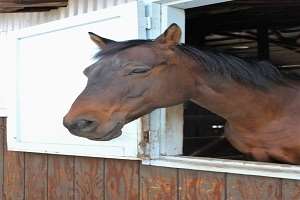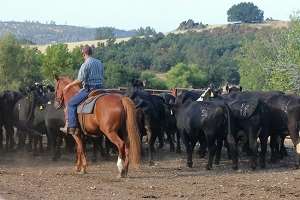Water is essential to your horse's overall health and well-being. A singular horse requires 5-15 gallons of water per day, so every horse should have access to clean, fresh water at all times. Your horse's water consumption can vary depending upon environmental temperature, diet, or level of exercise. It is important to pay special attention to your horse's drinking habits and note any changes. If your horse is a poor drinker or a heavy sweater, access to fresh, clean water alone may not be enough. Adding an over-the-counter, daily electrolyte supplement is a smart way to replace salt and the other minerals lost in sweat, and to help encourage your horse to drink. If your horse still isn't drinking enough water, contact your equine veterinarian for recommendations or other advice.
FEED
Horses are known as “trickle feeders,” meaning they constantly take in food throughout the day. If it were up to your horses, they would spend roughly 17-20 hours every day grazing on forage. Due to the scarcity of land with quality pasture, few domesticated horses have that luxury, so as owners we must compensate for their nutritional needs to the best of our abilities. Forage is the basis of an equine diet. This can include pasture, grass hay, legumes (ex. alfalfa), and/or beet pulp. These forages provide the essential proteins, carbohydrates, and fats every horse needs. Horses should consume 1.5%-3% of their body weight per day - with at least half of that being forage. That is 15-20 pounds of forage per day for an average-sized horse. Grain is not usually a necessary part of a horse's diet, but can be used as a supplement if needed or for horses expelling a lot of energy who may need an elevated calorie intake.
A horse's gastrointestinal system is very sensitive and drastic changes can cause colic. According to the UC Davis Equine Center's Equine Welfare Report, "colic" is a term that indicates clinical signs of pain in the abdominal cavity. It is not a specific disease, but rather a combination of signs that signal abdominal pain in the horse. You should take this into consideration when changing any part of your horse's diet.
Equine dietary requirements can vary by region, age, breed, and level of activity. Talk to your equine veterinarian or equine nutritionist to make sure your horse is getting the nutrients he needs.

SHELTER
Horses are a much hardier species then they are often given credit for. They can regulate their own body temperatures, allowing them to cope with both heat and cold. However, the availability of shelter can give them the opportunity to escape extreme conditions, such as heat, wind, precipitation, etc. Depending on the climate and/or season, the appropriate type of shelter can range from a stand of shade trees to a three-sided open barn or even an enclosed barn stall. The main consideration in a pasture setting is whether there is an adequate amount of shelter for the total number of horses housed in the pasture. For safety reasons it is very important that any shelter structure is sturdy and secure enough to withstand the elements.
While water, feed, and shelter encompass the most basic needs the horse, the following five guidelines are important as well and should not be forgone.
EXERCISE
Exercise is an important part of a horse's life and is essential for horses that are stabled. The amount and type of necessary exercise is dependent upon the breed of horse, the amount of activity they are prone to, and the conditions in which they are kept. Daily exercise can help prevent digestive issues (colic), and will stimulate improvement in a horse's physical and mental fitness. Different forms of exercise can include pasture turnouts, lunging, and riding.
COMPANIONSHIP
Horses are herd animals and as such, require some sort of companionship. Research has shown that horses develop a complex social network within a herd. Separation or isolation from herd mates can cause severe stress and/or undesirable personality traits. While they typically prefer their own species, horses have been known to bond with other companion animals as well. Balancing personality types in a pasture or turnout scenario can be a challenge, but overall it is beneficial for your horse to be able to socialize and interact as part of a herd.
FENCE SAFETY
Fence related lacerations and injuries are some of the most common afflictions equine veterinarians see. Even in the interest of injury prevention, you'll never be able to prevent every potential incident with your horse. You can, however, choose to enclose them in the safest fence possible. Wood plank, horse panels, and/or non-climb, woven wire with openings spaced two inches wide or smaller are thought to be some of the safest fencing choices for horses, but this does not limit you to other options that might be more fitting for your particular situation. You should always be aware of your fence's weak spots, and repair anything that looks like it could cause any sort of injury to your horse. In many horse fencing scenarios, barbed wire is not typically and ideal option.

HOOF CARE
Like fingernails or toenails on a human, a horse's hooves grow continuously and require regular care. The proper care of a horse's hooves is the key to keeping them comfortable and sound. Generally, horses require hoof care every 5-8 weeks depending on their hoof growth and activity. There are some horses that can go barefoot, while others may need specialized shoes or boots. Either way, you should schedule regular visits from a qualified farrier who can determine the proper care for your particular horse.
VACCINATIONS & HEALTH CARE
It is recommended that horses see a licensed equine veterinarian once each year for a wellness exam. During this exam your veterinarian will check your horse's teeth and evaluate their overall health and nutritional program. They will also be able to give you advice on parasite control (deworming). As a general rule of thumb horses should be dewormed at least two times per year, and possibly more if they are a moderate to high worm shedder. An annual exam is also a good opportunity for your horse to receive the American Association of Equine Practitioners (AAEP) core vaccines:
- Eastern/Western Equine Encephalomyelitis
- West Nile Virus
- Tetanus
- Rabies
Maintaining a good relationship with your equine veterinarian allows for open communication which will benefit both you and your horse. If you have any questions regarding a parasite control schedule or core vaccinations, call your local equine veterinarian.
One thing you can be certain of as a horse owner is that you will never stop learning. Please allow these basic guidelines to help you have good conversations with your local veterinarian, farrier, other horse care professionals, as well as fellow horse owners.
Source: ucanr.edu